DES 2016. Final (Part 51)
11) A female infant is born full-term to a 24-year-old Caucasian primigravida. The delivery was uncomplicated. The Apgar scores were 7 and 8 at 1 and 5 minutes, respectively. The prenatal course was complicated with asymptomatic bacteriuria that was treated with an antibiotic. The mother took multivitamins during her last trimester, occasionally took acetaminophen for back pain throughout the pregnancy, and denies smoking and alcohol consumption. Physical examination of the infant reveals a blood-tinged vaginal discharge and bilaterally enlarged mammary glands. What is the best next step in the management of this patient?
Buccal smear
Urinary corticosteroid precursor measurement
FSH/LH assay
Imaging studies to visualize adrenals
Observation and routine care
12) The mother of a 2-year-old girl reports that her daughter complains of burning when she urinates and that she has foul-smelling discharge from her vagina. She has some slight staining on the front of her underwear, but denies fever, nausea, vomiting, or other constitutional signs. The child does not attend day care, and she has demonstrated no change in behavior. The physical examination is normal with an intact hymen, but the child’s vulva is reddened and with a malodorous scent noted. Her urinalysis and culture are normal. Management of this condition includes which of the following?
Complete genitourinary (GU) examination under general anesthesia
Progesterone cream to the affected area for a week
Advice to stop taking prolonged bubble baths
Mebendazole to eradicate pinworm infestation
Referral to social services for possible sexual abuse
13) A 12-year-old boy comes to the emergency department at midnight with a complaint of severe scrotal pain since 7 PM. There is no history of trauma. Which of the following is the most appropriate first step in management?
Order a surgical consult immediately
Order a radioisotope scan as an emergency
Order a urinalysis and Gram stain for bacteria
Arrange for an ultrasound examination
Order a Doppler examination
14) A 12-year-old boy presents with an intensely pruritic rash for 3 days. He just went on a camping trip, during which he wore only short-sleeve shirts and short pants. His temperature is 37.6 C (99.7 F), blood pressure is 96/62 mm Hg, pulse is 65/min, and respirations are 12/min. There are numerous erythematous papules and vesicles on both arms and legs. Most of them are in a linear array. Which of the following is the most appropriate pharmacotherapy?
Oral cephalexin
Oral prednisone
Topical diphenhydramine
Topical mupirocin
Topical 1% hydrocortisone
15) A 5-year-old boy suddenly begins coughing while eating peanuts. He is choking and gagging. When he is brought to the emergency department, but he is awake and is able to give his name. On physical examination, his vital signs are stable. On examination of the chest, inspiratory stridor and intercostal and suprasternal retractions are apparent. Which of the following is the most appropriate initial step in management?
Allow patient to clear foreign object by spontaneous coughing
Clear oropharynx with multiple blind sweeps with finger
Position patient and perform back blows
Stand behind patient and perform abdominal thrusts
Perform emergency tracheostomy and take to surgery
16) A 9-year-old boy is rushed to the emergency department after having a seizure. He is visiting his grandparents for the weekend. His past medical history is insignificant. When the grandmother is questioned about any medications, she replies with, "He isn't taking any medications, but I'm taking nortriptyline, and my husband is taking atenolol and enalapril." The boy's blood pressure is 80/40 mmHg and pulse is 90/min. Physical examination reveals dry oral mucosa and dilated pupils. His answers are adequate, but delayed. EKG shows wide QRS complexes. What is the best next step in the management of this patient?
. Physostigmine
. Propranolol
Sodium bicarbonate
. Phenytoin
Observation
17) A 1-month-old infant is brought to the office for a routine neonatal visit. His prenatal and birth histories are unremarkable. His vital signs are normal. Examination reveals a harsh, loud holosystolic murmur over the left, lower sternal border. Palpation reveals a thrill over the precordial region. There is no cyanosis, and pulmonary auscultation reveals no rales. Chest radiograph reveals a heart of normal size and a slight increase in pulmonary vascularity. EKG is normal. Which of the following is the most appropriate course of action?
. PGE 1 administration
Oxygen administration
Digoxin and diuretic therapy
Surgical repair
Reassurance
18) A 19-year-old male college student returns from spring break in Fort Lauderdale, Florida, with complaints of acute pain and swelling of the scrotum. Physical examination reveals an exquisitely tender, swollen right testis that is rather hard to examine. The cremasteric reflex is absent, but there is no swelling in the inguinal area. The rest of his genitourinary examination appears to be normal. A urine dip is negative for red and white blood cells. Which of the following is the appropriate next step in management?
Administration of antibiotics after culture of urethra for Chlamydia and gonorrhea
. Reassurance
Intravenous fluid administration, pain medications, and straining of all voids
Ultrasound of the scrotum
Laparoscopic exploration of both inguinal regions
19) A 7-day-old female neonate is brought to your office for a 2-day history of jaundice and poor feeding. According to the mother, she has vomited twice but doesn't appear febrile. She is regularly breastfed. Her birth history is unremarkable. On examination, she appears listless, and mild jaundice, along with signs of dehydration, are noted. Her blood pressure is 78/52mm Hg, pulse rate is 150/min, and temperature is 36 C (96 F). Her family history is insignificant. What is the most appropriate next step in the management of this patient?
Stop breast feeding
Obtain blood cultures and lumbar puncture
Obtain peripheral smear and reticulocyte count
Obtain liver function tests
Obtain Coomb's test and osmotic fragility test
20) The father of a 1-week-old infant comes to the office in a panic. He has just noticed on his child a right anterior shoulder mass that seems ten- der. The father is an osteosarcoma survivor and fears the child has the same malignancy. In reviewing the baby’s discharge papers, you note the child was a term, appropriate-for-gestational-age vaginal delivery with a birth weight of 3200 g (7 lb, 1 oz). Apgar scores were 9 at 1 and 5 minutes. Your examination is significant for a large firm mass on the right clavicle; the rest of the examination is normal. Management of this problem should include which of the following?
Magnetic resonance imaging of the right shoulder
Reassurance and supportive care
A biopsy of the mass for culture and cytology
Referral to an orthopedic surgeon
Skin biopsy to test for osteogenesis imperfecta
21) A 7-year-old girl complains of increased urinary frequency, dysuria and itching on urination. Her urinalysis is consistent with a urinary tract infection. This is her 20th infection in the past year, despite adequate antibiotic coverage. Further imaging of her bladder, kidneys and ureter reveals is consistent with vesicoureteral reflux. Which of the following is the next appropriate step?
. CT scan of the pelvis.
Intravenous antibiotics for two weeks
Intravenous pyelogram
. Renal arteriogram
Antireflux surgery
22) A 3-year-old girl is believed to have swallowed a marble. She presents to the emergency department unable to speak and begins to become cyanotic. Initial attempts at endotracheal intubation are unsuccessful. Which of the following is the most appropriate next step in management?
Continued attempts at endotracheal intubation
Crkothyroidotomy (surgical)
Face mask 100% 02 with succinylcholine
Formal tracheostomy
Needle crkothyroidotomy
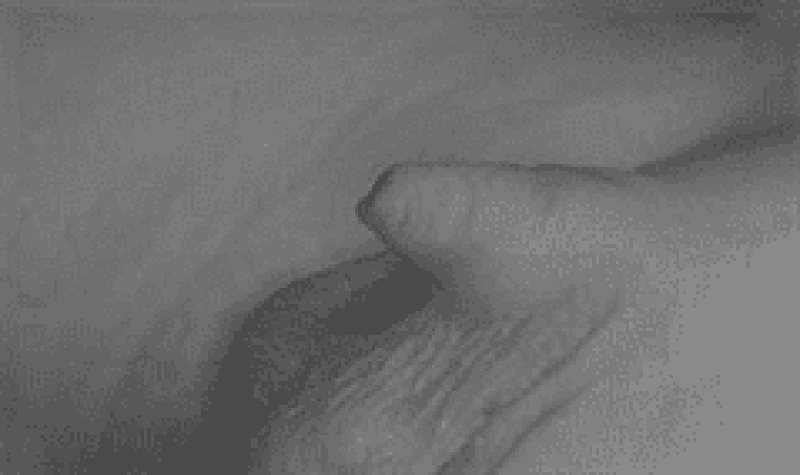
23) A chubby 6-month-old baby boy is brought to the clinic by his father. His father is concerned that his penis is too small (see photograph). The child is at the 95% for weight and the 50% for length; he has been developing normally and has had no medical problems. Which of the following is the most appropriate first step in management of this child?
Surgical consultation
Evaluation of penile length after retracting the skin and fat lateral to the penile shaft
Ultrasound for uterus and ovaries
Weight loss
Serum testosterone levels
24) A previously normal newborn infant in a community hospital nursery is noted to be cyanotic at 14 hours of life. She is placed on a face mask with oxygen flowing at 10 L/min. She remains cyanotic, and her pulse oximetry reading does not change. An arterial blood gas shows her PaO2 to be 23 mm Hg. Bilateral breath sounds are present, and she has no murmur. She is breathing deeply and quickly, but she is not retracting. While you are waiting for the transport team from the nearby children’s hospital, you should initiate which of the following?
Indomethacin infusion
Saline infusion
Adenosine infusion
Prostaglandin E1 infusion
Digoxin infusion
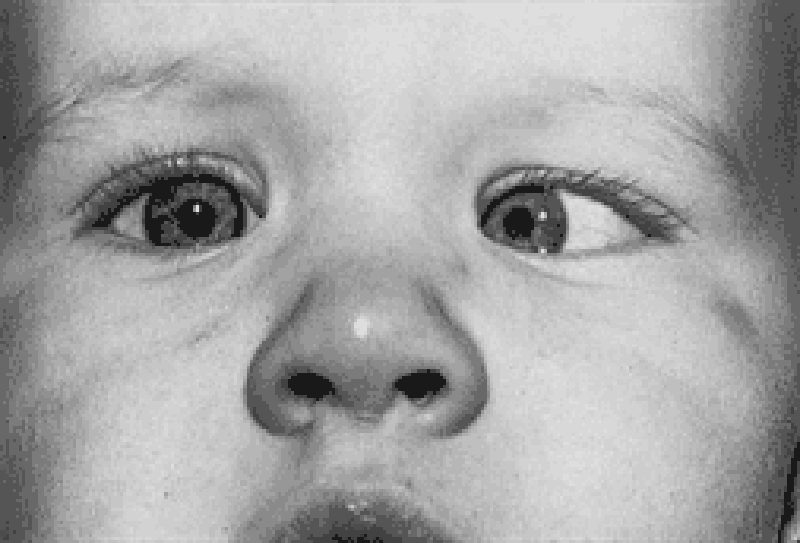
25) You are performing a well-child examination on the 1-year-old child shown in the picture. For this particular problem, which of the following is the most appropriate next step in management?
Patch the eye with the greater refractive error
Patch the eye that deviates
Defer patching or ophthalmologic examination until the child is older and better able to cooperate
Reassure the mother that he will outgrow it
Refer immediately to ophthalmology
26) A mother brings her 4-year-old son to see you. She seems to be very concerned about her child's bedwetting. As you explore the history, the mother tells you that she started his toilet training when he was 2 years old. The child responded to his mother's efforts and slowly was able to reduce the frequency of bedwetting. However, he did not completely succeed and still occasionally wets his bed. She has become so concerned that she demands you to order tests and prescribe some drugs to resolve the problem. What is your best next step in the management of this boy?
Mmediately do an ultrasonogram, intravenous pyelogram and cystometrogram to establish a baseline level of functioning.
Start desmopressin for incontinence and antibiotics for the child's urinary tract infection.
Do a KUB and then check for vesica-ureteric reflex.
Do urinalysis followed by culture and microscopy.
Reassure the mother that everything is normal and it will resolve with age
27) A 20-year-old female is brought to the Emergency Room by her college roommate who states that the patient vomited all night. The patient complains of a sore throat and says she has not eaten for the last two days. She admits to a "sugar problem" and quit taking her medication because she has not been eating. Examination reveals an ill-appearing woman. Her temperature is 37.9 C (100.2 F), blood pressure is 118/78 mm Hg, pulse is 160/min, and respirations are 30/min. The patient's lips and mucous membranes are dry. There is a fruity odor noted to the patient's breath. The lung and cardiac examination are unremarkable except for mild tachypnea and tachycardia. Laboratory analysis shows: Sodium 130 mEq/L, Potassium 6.1 mEq/L, Chloride 100 mEq/L, Bicarbonate 8 mEq/L, Urea nitrogen 10 mg/dL, Creatinine 1.0 mg/dL, Glucose 680 mg/dL, pH 7.15, pCO2: 30 mm Hg, pO2: 85 mm Hg, Urinalysis is positive for ketones. Which of the following is the most appropriate initial step in management?
. Immediate intubation
. Intravenous insulin
. Intramuscular ceftriaxone
. IV fluid bolus with normal saline and potassium
. Mannitol
28) A new mother complains that her 6-week-old infant frequently regurgitates small volumes of formula during and after feedings. Physical examination demonstrates a happy baby who has gained half a pound since his last visit. No abdominal masses are noted. Which of the following is the best next step in management?
Change the baby's formula
Change the bottle's nipple
Monitor the baby carefully
Order abdominal x-rays
Order CT of the abdomen
29) A 3-year-old girl presents to the pediatrician's office. The mother states that the girl has been having big, bulky stools that float in the toilet. She also has intermittent diarrhea. On examination, her height is 88 cm (34.6 in, <5th percentile) and weight is 15.8 kg (34.8 lb, <5th percentile). In addition, she has an uncle who died of recurrent lower respiratory infections. Which of the following would be most effective for alleviating the gastrointestinal symptoms of this patient?
Avoidance of dairy products
Elimination of dietary fat
Ketogenic diet
Oral metronidazole
Pancreatic enzyme replacement
30) A 14-year-old girl with a history of seizures is admitted to the hospital with the diagnosis of status epilepticus. Her valproic acid level is in the therapeutic range. You arrange a 24-hour video electroencephalogram (EEG). During the EEG, she has several episodes of tonic and clonic movements with moaning and crying, with no loss of bowel or bladder control. The neurologist tells you that during the events the EEG had excessive muscle artifact but no epileptiform discharges. Which of the following treatments is the most appropriate for this condition?
Add a scheduled benzodiazepine for her muscular symptoms
Add carbamazepine to her current seizure medication
. Increase her dose of valproic acid
Withdraw all seizure medications
Request a psychiatric evaluation
31) A 5-year-old African-American boy is brought to the office by his mother due to a painful right knee, fever and chills over the last 2 days. The child was diagnosed with pharyngitis 2 weeks ago, and was treated with a 10-day course of penicillin G. His temperature is 38.8 C (102F) and pulse rate is 102/min. On examination, his right knee joint is swollen and erythematous, with a decreased range of motion. The laboratory findings are significant for leukocytosis and an elevated ESR. X-rays of both the right hip and knee joints are normal. What is the most appropriate treatment for the patient's condition?
Bed rest with the right knee joint in a position of comfort
Repeat a ten-day course of penicillin G
Bed rest & a ten-day course of penicillin G
Bed rest & aspirin
Right knee arthrocentesis & intravenous nafcillin
32) A 12-year-old boy comes to the emergency department with severe shortness of breath, cough, and fever. He was diagnosed with cystic fibrosis when he was five years old. He is currently not taking any medications. His temperature is 39.4 C (103F), blood pressure is 80/40 mmHg, pulse is 120/min, and respirations are 30/min. He is excessively using his accessory respiratory muscles. Lung auscultation reveals bilateral lower lobe crackles and expiratory wheezing. Pulse oximetry shows Sa02 of 85% that improves to 92% after oxygen supplementation. Which of the following antibiotics or combinations is the best choice for this patient?
Intravenous ceftazidime and gentamicin
Intravenous vancomycin and gentamicin
Intravenous imipenem/cilastatin
Intravenous clindamycin
Oral ciprofloxacin
33) A 7-month-old boy is brought to his physician because of increased agitation and restlessness. Lung examination reveals crackles and decreased breath sounds bilaterally. Chest x-ray films are notable for bilateral pneumonia. Arterial blood gas analysis reveals an oxygen tension of 45 mm Hg and a carbon dioxide tension of 60 mm Hg. Which of the following is the most appropriate next step in management?
Obtain blood cultures
Administer oxygen
Administer bronchodilators
Administer antibiotics
Insert endotracheal tube
34) You have just given a 10-year-old boy an injection of pollen extract as prescribed by his allergist. You are about to move on to the next patient when the boy starts to complain about nausea and a funny feeling in his chest. You note that his face is flushed and his voice sounds muffled and strained. Which of the following is the first priority in managing this episode of anaphylaxis?
Preparation for endotracheal intubation
Intramuscular injection of diphenhydramine
Administration of oxygen
Subcutaneous injection of 1:1000 epinephrine
Administration of corticosteroids
35) A 5-year-old girl without past history of UTI is in the hospital on antibiotics for Escherichia coli pyelonephritis. She is still febrile after 4 days of appropriate antibiotics. A renal ultrasound revealed no abscess, but a focal enlargement of one of the lobes of the right kidney. CT of the abdomen reveals a wedge shaped area in the right kidney distinct from the normal tissue with minimal contrast enhancement. Appropriate management of this patient includes which of the following interventions?
Prolonged antibiotic therapy
Routine treatment with 10 to 14 days of antibiotics for pyelonephritis
Surgical consultation
Dimercaptosuccinic acid (DMSA) scan
Renal biopsy
36) A 6-year-old boy is brought to the office due to a sudden onset of petechiae and epistaxis. Three weeks ago, he had an upper respiratory tract infection which resolved uneventfully. Physical examination shows a few petechiae over the trunk and extremities, but is otherwise unremarkable. Laboratory studies show: Hb 13.5g/dL, WBC 7, 000/mm3, Differential count normal, Platelets 60, 000/mm3. What is the most appropriate next step in the management of this patient?
Platelet transfusion
IV antibiotics
Observation
Splenectomy
Intravenous immunoglobulin
37) A 6-year-old boy is brought to the pediatrician because of a 3-day history of skin lesions. On physical examination, he has multiple yellow, crusted erosions below the nares and on the cheeks, chin, and upper extremities. The rest of the examination is normal. Which of the following is the most appropriate treatment for this condition?
Oral acyclovir
. Oral amoxicillin
Oral cephalexin
. Topical ketoconazole
Topical 2% hydrocortisone
38) A 10-year-old girl comes to medical attention because of recurrent attacks of wheezing and dyspnea. The attacks occur mostly at home or, if outdoors, soon after exercise. Exacerbations are noted in springtime. The severity of symptoms is mild- Pulmonary function tests show that peak expiratory flow (PEF) and forced respiratory volume per second (FEVj) are reduced during an attack but are relatively normal during symptom-free intervals. Height and weight are in the 60th percentile. Complete blood count shows 8% eosinophils; all other parameters are normal. Cutaneous testing shows the patient to be allergic to a variety of allergens, including dust mites, animal dander, and several pollens. Which of the following is the most effective step in management?
Avoidance of exercise
Avoidance of respiratory irritants, such as cigarette smoke
Use of a humidifier at home
Use of air cleaners at home
Administration of multiple-drug regimens
39) A 3-year-old African-American female is brought to the office due to a swelling in her abdomen. According to her parents, this swelling was first noted when she was 3 months old, and has been increasing in size over the past 6 months. It is more pronounced during crying and coughing. Examination reveals a soft swelling of the umbilical region that is 3 cm in diameter and covered by skin. It can be easily reduced through the fibrous ring at the umbilicus. The child is afebrile and in good health. What is the most likely diagnosis and best course of action for this patient?
Umbilical hernia, refer to pediatric surgeon for operative management
Umbilical hernia, observe for spontaneous resolution
Congenital omphalocele, refer to pediatric surgeon
Umbilical polyp, surgical excision
Gastroschisis, surgical management
40) The mother of a 2-year-old male child states that she has noticed white, cheeselike material arising from his foreskin and also that he cannot fully retract the foreskin behind the glans penis. Which of the following is the correct advice for this parent?
The child has phimosis and requires a circumcision
The child has paraphimosis, and in addition to a circumcision, likely has an infection requiring topical antibiotics
The child is normal
. The child likely has a previously undiagnosed hypospadias
. Ultrasound of kidneys, bladder, and ureters is indicated to check for unidentified associated defects
41) You are called to examine a newly delivered infant, who is 41 weeks gestation and a product of an uncomplicated pregnancy. Physical examination reveals a matted mass of edematous bowel loops protruding from the abdomen. There is no covering over the bowel loops. The umbilical cord appears normal. Which of the following is the best next step in the management of this patient?
Intravenous nutrition
Sterile wrapping of exposed bowel
Immediate surgery
Look for associated anomalies
Initiate broad-spectrum antibiotics
42) A frantic mother telephones the pediatric office. She reports that her 10-year-old boy accidentally splashed Drano (a strongly corrosive, alkaline drain cleaner) on his face, and he is screaming in pain complaining that his right eye hurts terribly. Which of the following is the best advice to give to the mother?
Apply antibiotic ointment to the eye and make an appointment with an ophthalmologist
Bring the boy to the hospital right away
Pry the eye open and drip vinegar over it until the pain goes away
Pry the eye open and swipe it clean with a tissue before bringing the boy in for further evaluation
Pry the eye open, hold it under running cold water for about 30 minutes, and then bring the boy to the hospital
43) A 3-year-old boy is brought to the emergency department because of a worsening cough over the past week. His temperature is 38.9 C (102 F), and inspiratory stridor is noted. A plain film of the neck reveals subglottic swelling. He is noted to have copious thick secretions and a barking cough. He has not had such events previously, and his parents deny recent contact with sick children. The patient is in respiratory distress and is noted to be retracting his subcostal muscles to breathe. Which of the following is the next most appropriate step in management?
Administer albuterol
Administer racemic epinephrine
Administer corticosteroids
Administer IV penicillin
Endotracheal intubation
44) A 14-year-old boy is hit by an automobile while walking across the street and is immediately taken to the emergency department. On arrival, he is conscious and complains of shortness of breath and chest pain. Physical examination reveals an ecchymotic area over his right chest and subcutaneous emphysema. Breath sounds are absent on the right side. His trachea is deviated to the left, and his right hemithorax is tympanic to percussion. Which of the following is the most appropriate initial step in management of this patient?
. 12-lead ECG
. CT of the chest
Plain radiography of the chest
Chest tube thoracostomy
. Pericardiocentesis
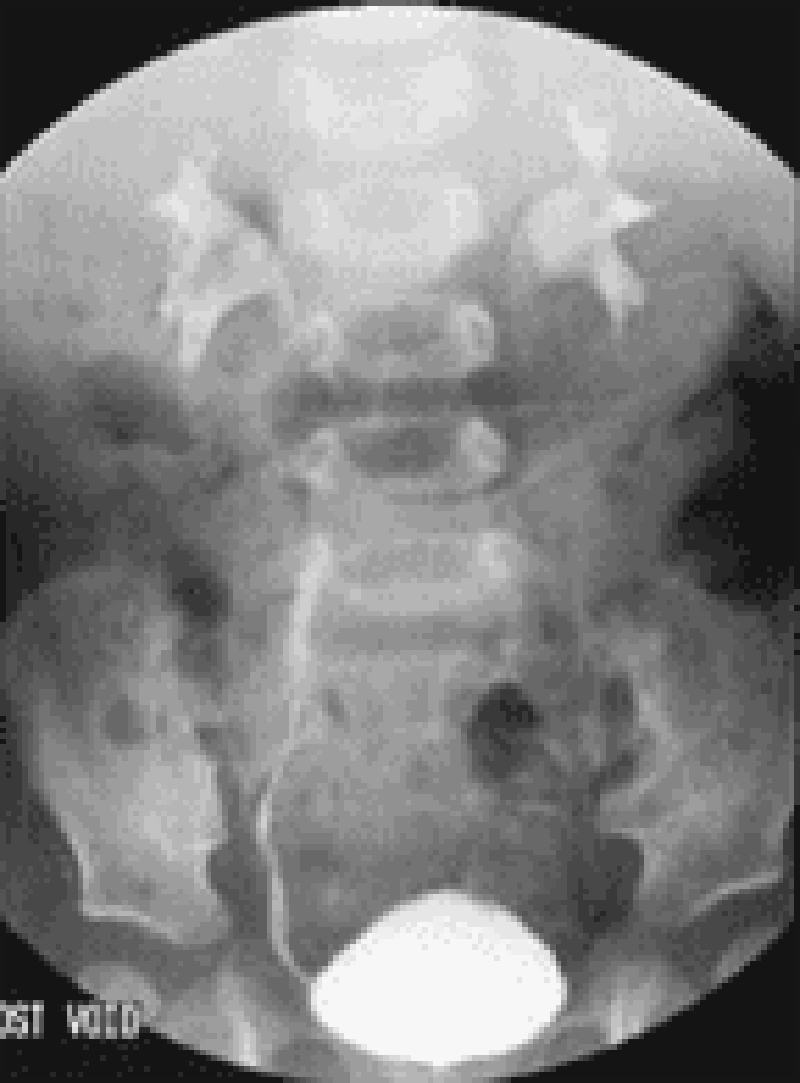
45) After her first urinary tract infection, a 1-year-old has a voiding cystourethrogram with findings shown below. Which of the following is the most appropriate treatment option?
. Low-dose daily antibiotics
Immediate surgical reimplantation of the ureters
Weekly urinalyses and culture
Diet low in protein
Early toilet training
46) A 4-year-old boy is brought to the emergency department for a painful and swollen right forearm. He was bitten and scratched by a family cat 2 days ago in the affected area. His temperature is 39.6 C (103.2 F). The right forearm is erythematous, edematous, and tender to touch. Which of the following is the most appropriate antibiotic treatment for this patient?
. Ampicillin
. Amoxicillin-clavulanate
. Clindamycin
. Tetracycline
. Trimethoprim-sulfamethoxazole
47) A 6-year-old boy is brought to the office by his parents after hearing that chicken pox is infectious and can occur in unimmunized contacts. One week ago, he and his family visited relatives, and one of his cousins had chicken pox at that time. He and his two other siblings are apparently healthy, and never had any "chicken pox shots." What is the best next step in the management of this patient?
Administer varicella vaccine to the patient
Give intravenous immunoglobulins to the patient
Administer varicella vaccine and intravenous immunoglobulins to the patient
Administer acyclovir to the patient
Tell the parents that the patient might develop a rash within the next two weeks
48) A 5-year-old Mexican female child is brought to the office for the evaluation of a pruritic vulva for the past fifteen days. The pruritus is felt mostly during the night. Her 4-year-old cousin who visited them four weeks ago has a similar complaint. On examination, there is no vaginal discharge, but the vulva is erythematous. The rest of the physical examination is normal. What is the most appropriate next step in the management of this patient?
Detain the child with the suspicion of sexual abuse
Do a scotch tape test
Do stool examination for parasites
Do vaginal fluid gram stain
Do wet mount of vaginal fluid
49) A newborn girl is noted to be drooling saliva, and she chokes violently when she is first fed. On physical examination, she is found to have abdominal distention and an imperforate anus. There is no fistula to the perineum or vagina. Examination of the urine reveals no meconium in it. Echocardiogram and renal sonogram are reported as negative for other congenital defects. X-ray films show abundant gas in the gastrointestinal tract. Pictures taken with a metal marker taped to the anus, and the baby hanging upside down, show that there is a significant distance (2.5 cm) between the blind end of the rectum and the anal marker. Before a diverting colostomy is performed, which of the following steps should be taken?
. A soft nasogastric tube passed, and x-rays taken
. Barium injected through the anal dimple
. Barium swallow
. Nasogastric suction for at least 24 hours
. Surgical exploration of the perineum to see whether a primary repair is possible
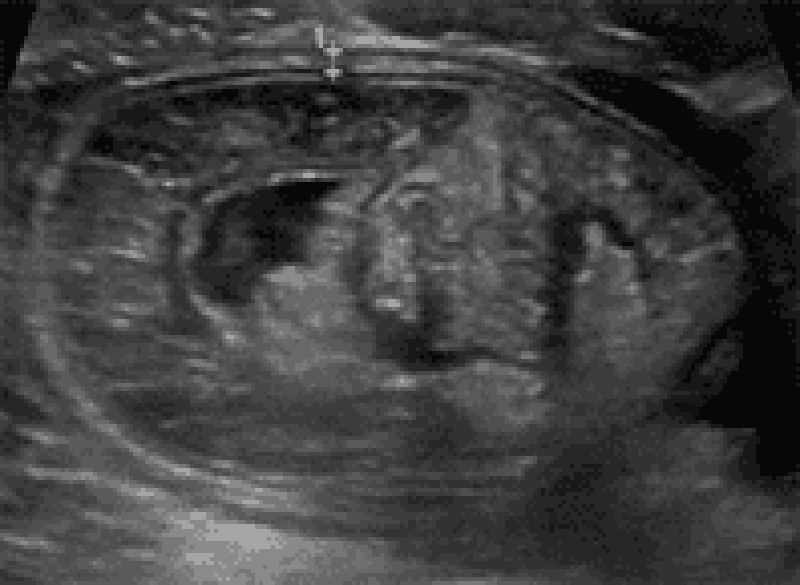
50) A previously healthy 3-year-old male is brought to the emergency department with abdominal pain. The abdominal pain began several hours ago. Since then, he has had several episodes in which he clutches his stomach and screams. These episodes are associated with nonbloody, nonbilious vomiting and loose, watery stools. Between the episodes, the patient denies abdominal pain and is playful. On examination, his temperature is 99F (37.2C), pulse is 100/min, respiratory rate is 20/min, and blood pressure is 85/50 mmHg. The child is alert and in no acute distress. Abdominal examination reveals a soft, nontender, nondistended abdomen with bowel sounds present in all four quadrants. A tubular mass is felt in the right upper quadrant, and a rectal exam is hemoccult positive. An ultrasound image of the patient's abdomen is shown below. What is the best next step in the management of this patient?
Emergent laparotomy
Computed topography of the abdomen
Laparoscopic cholecystectomy
Air contrast enema
Meckel's scan
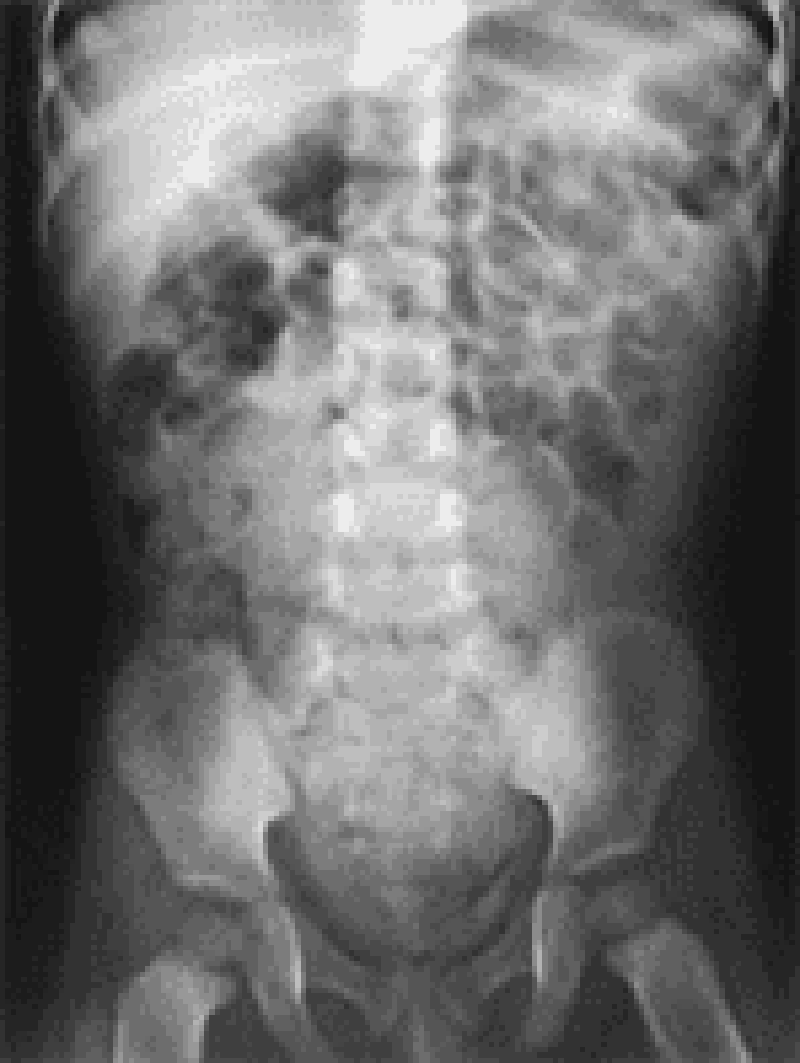
51) A 4-year-old boy presents with a history of constipation since the age of 6 months. His stools, produced every 3 to 4 days, are described as large and hard. Physical examination is normal; rectal examination reveals a large ampulla, poor sphincter tone but present anal wink, and stool in the rectal vault. The plain film of his abdomen is shown. Which of the following is the most appropriate next step in the management of this child?
. Lower gastrointestinal (GI) barium study
. Parental reassurance and dietary counselling
. Serum electrolyte measurement
. Upper GI barium study
. Initiation of thyroid-replacement hormone
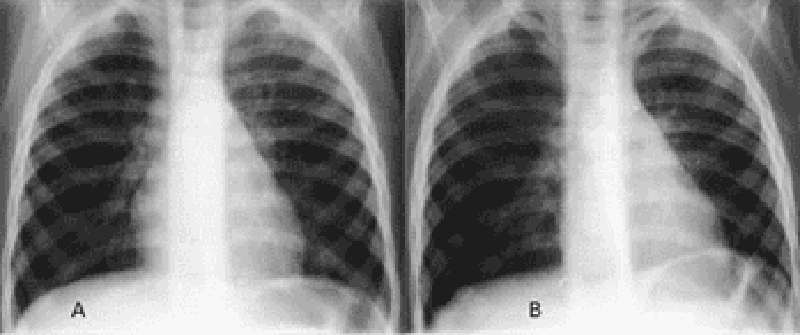
52) A previously healthy 2-year-old black child has developed a chronic cough during the previous 6 weeks. He has been seen in different emergency rooms on two occasions during this period and has been placed on antibiotics for pneumonia. Upon auscultation, you hear normal breath sounds on the left. On the right side, you hear decreased air movement during inspiration but none upon expiration. Inspiratory (Image A) and expiratory (Image B) radiographs of the chest are shown below. Which of the following is the most appropriate next step in making the diagnosis in this patient?
Measure the patient’s sweat chloride
Consult pediatric surgery for bronchoscopy
Prescribe broad-spectrum oral antibiotics
Initiate a trial of inhaled β-agonists
Prescribe appropriate doses of oral prednisone

53) A 13-year-old boy has a 3-day history of low-grade fever, symptoms of upper respiratory infection, and a sore throat. A few hours before his presentation to the emergency room, he has an abrupt onset of high fever, difficulty swallowing, and poor handling of his secretions. He indicates that he has a marked worsening in the severity of his sore throat. His pharynx has a fluctuant bulge in the posterior wall. A soft tissue radiograph of his neck is shown. Which of the following is the most appropriate initial therapy for this patient?
Narcotic analgesics
Trial of oral penicillin V
Surgical consultation for incision and drainage under general anesthesia
Rapid streptococcal screen
Monospot test
54) A 16-year-old boy presents with a temperature of 38.4 C (101 F) and low back, wrist, and knee pain. He had a sore throat 1 month earlier. His arthritis is diffuse. Pea-sized swellings are noted over the skin on his knees. He has a serpiginous erythematous area on his anterior trunk. His blood and throat cultures are negative, and his CBC is unremarkable. His antistreptolysin-O (ASO) titer is high. Which of the following is the most appropriate therapy?
. Acetaminophen
. Aspirin
. Penicillin
. Penicillin and aspirin
. Supportive care
55) A 2-year-old child is brought by an anxious mother to the emergency department because of difficulty in breathing for the past 12 hours. The child has a history of runny nose that started 3 days ago. He suddenly developed a progressively increasing difficulty in breathing. The mother reports that the child "sounds like a barking dog when he coughs." The child's temperature is 37.7C (99.9F), respirations are 30/min, blood pressure is 90/60mm Hg, and pulse rate is 104/min. He is coughing and using his accessory muscles of respiration. His oxygen saturation is 98% on 2L of oxygen. He is diagnosed with laryngotracheobronchitits, started on humidified oxygen, and kept in an upright position. After 20 minutes, he becomes more irritable, his oxygen saturation drops to 92%, respirations increase to 40/min, and pulse increases to 120/min. His blood pressure and temperature are unchanged. What is the most appropriate next step in the management of this patient?
Continue the same therapy
Take the patient to the operating room
Consult the anesthesiologist
Intubate the patient in the emergency room
Start racemic epinephrine
56) A 16-year-old girl is being evaluated for primary amenorrhea. Her birth history is significant for low birth weight and bilateral swelling of the hands and feet. Her blood pressure is 170/96 mmHg. She has a short stature and webbed neck. Her karyotype examination results show 22 pairs of autosomes, one X, and one Y chromosome. Which of the following statements is true regarding this patient's condition?
The primary amenorrhea in this girl is most likely caused by functional uterine abnormalities
The girl should undergo bilateral abdominal gonadectomy
The webbing of the neck is caused by defects in arteriovenous communications
The inheritance for this condition is Mendelian dominant
This child will benefit from steroid hormone replacement therapy
57) An 8-year-old girl presents with well-controlled, moderately persistent asthma. Her therapies consist of occasional use of short-acting β-agonists, daily inhaled steroids, and a leukotriene inhibitor. She presents with white patches on her buccal mucosa. You recommend which of the following?
HIV testing
Tuberculosis skin testing
Measurement of serum immunoglobulins
Discontinuation of all her asthma medications
Rinse her mouth after use of her inhaled medications
58) A 7-year-old boy is referred for genetic testing because his father was diagnosed with medullary cancer of the thyroid. The father underwent a total thyroidectomy, and in the preoperative workup it was determined that he also had a pheochromocytoma, and that tumor was removed also. The father did not have parathyroid hyperplasia at the time, his phenotype was normal, and his final diagnosis was MEN-2A. The child is tested and found to have RET mutations in the peripheral white blood cells. The child has normal phenotype, normal levels of calcitonin, normal levels of catecholamines, metanephrines, and VMA, and normal levels of calcium and parathyroid hormone. Which of the following is the most appropriate management?
Bilateral adrenalectomies
Continued observation
MRI of the pituitary
Parathyroid surgical exploration
Total thyroidectomy
59) A 4-year-old girl with sickle cell disease presents to the emergency department with a temperature of 39.6 C (103.2 F). Other than irritability, the physical examination is unremarkable. Laboratory evaluations reveal a white blood cell count of 18,200/mm3, with 88% polymorphonuclear neutrophils, 10% lymphocytes, and 2% monocytes, and a hemoglobin of 7.6 g/dL. Which of the following is the most appropriate next step in management?
. Observe the child pending blood culture results
. Administer amoxicillin orally
. Administer ceftazidime and gentamicin intravenously
. Administer ceftriaxone intravenously
. Administer vancomycin and gentamicin intravenously
60) A 9-month-old, chubby, healthy-appearing boy is brought to the pediatrician because of episodes of colicky abdominal pain and blood-tinged stools. The pain lasts from 1 to 10 minutes and causes the infant to double up; he then appears normal until his next bout of colic. During the examination, the infant has another episode, at which time a vague mass can be felt on the right side of the abdomen, and the right lower quadrant has an "empty" feeling to deep palpation. Which of the following is the most appropriate initial step in management?
Barium enema
Colonoscopy
Gastrografin enema
Upper gastrointestinal endoscopy
Exploratory surgery
61) You are seeing a 2-year-old child, brought by his father for a well-child examination. In providing age-appropriate anticipatory guidance, you should tell him which of the following?
He should set his water heater to 71 C (160 F) to ensure the sterility of dishes and clothes, thereby decreasing the risk of infections
Milk should be switched from whole to skim or low fat
Continue rear facing car seats
Purchase a bed alarm to assist with the child’s nocturnal enuresis
Teach the child to swim so that the parents have the ability to allow the child to be alone in pools
62) A 7 -day-old male infant is brought by his mother complaining of decreased movements of his right arm. She denies any trauma or fall. Pregnancy was uneventful, but delivery was complicated with shoulder dystocia. Examination reveals the presence of crepitus and bony irregularity over the clavicular area and Mora reflex is absent on the right. Which of the following is the most appropriate management?
Reassurance
Figure-of-eight clavicle strap
Passive and active motion exercises
Nerve grafting
Casting of the right arm and shoulder
63) A 16-year-old girl has had a fever, vomiting, and watery diarrhea for the past 24 hours. She also complains of intermittent abdominal pain and generalized myalgia. On examination, she is slightly lethargic. Her temperature is 39.4 C (103 F), blood pressure is 75/50 mm Hg, and pulse is 150/min. Her conjunctivae and pharynx are hyperemia. She has a generalized erythematous maculopapular rash that spares the wrists. Which of the following will be the most appropriate treatment?
Amantadine
Gentamicin
Ketoconazole
Nafcillin
Prednisone
64) An 8-month-old infant, who is up-to-date with his immunizations, is brought to the clinic by his mother. The mother states that she overheard other mothers talking about a varicella vaccination that their children have received. She does not want her son to have the chickenpox virus and therefore, wants him to receive the vaccine today. The physician explains that the infant has not yet reached the recommended age for the vaccine. If this visit is in November, when is the earliest that this patient can return for the varicella vaccine?
. February
. March
. April
. May
. June
65) An 11-year-old girl is brought to the office by her mother due to headaches for the last 4 hours. The headaches are bifrontal, and are accompanied by nausea, vomiting, and sensitivity to light and noise. It is her second episode, and both episodes were preceded by dark spots in her visual field. The first episode was 2 weeks ago. She doesn't report any numbness or tingling in her extremities, and no behavioral change or decline in school performance was noted. Her vital signs are stable, and she is afebrile. The physical examination is normal. What is the most appropriate next step in the management of this patient?
Reassurance and acetaminophen
Lumbar puncture
CT scan of the head
MRI of the brain
Electroencephalogram
66) A previously healthy one-year-old child is brought to the physician for a routine wellness visit. Her parents report that she drinks six glasses of whole milk a day, but is a very picky eater. She is developmentally appropriate. Her parents are concerned that she might be anemic because she frequently eats ice and sometimes dirt. On examination, her temperature is 88.6F (37 C), pulse is 118/min, and respiratory rate is 21 /min. Her height and weight are both at the 50th percentile for her age. She appears well nourished and her physical examination is unremarkable. Laboratory findings include the following. Complete blood count: Hemoglobin 10.5 g/dL, MCV 70 fl, Reticulocytes 1.0%, Platelets 250,000/mm3, Leukocyte count 6,500/mm3, Neutrophils 56%, Lymphocytes 33%, Monocytes 10%. Which of the following is the most appropriate next step in the management of this child?
Hemoglobin electrophoresis
Colonoscopy
Serum creatinine
Oral iron therapy
Blood transfusion
67) An inner city family has been using a neighbor to care for their 3-year-old child while the parents work. The neighbor is diagnosed with pulmonary tuberculosis. PPD test of the 3-year-old is negative. Which of the following is indicated for the 3-year-old?
. Ethambutol chemoprophylaxis
. Isoniazid chemoprophylaxis
. Rifampin chemoprophylaxis
. Streptomycin chemoprophylaxis
. No chemoprophylaxis
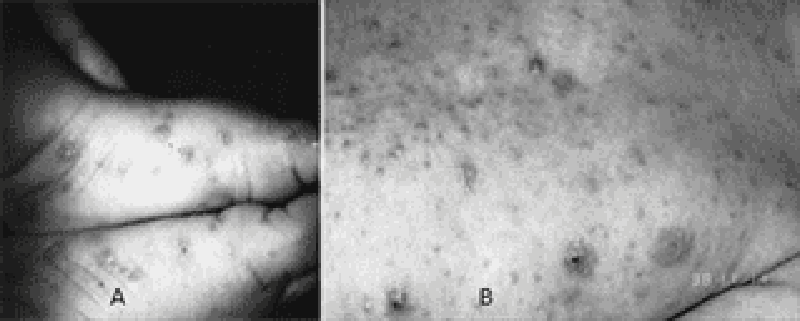
68) A 2-year-old child (Image A) presents with a 4-day history of a rash limited to the feet and ankles. The papular rash is both pruritic and erythematous. The 3-month-old sibling of this patient (Image B) has similar lesions also involving the head and neck. The most appropriate treatment for this condition includes which of the following?
Coal-tar soap
Permethrin
Hydrocortisone cream
Emollients
Topical antifungal cream
69) An 8-year-old male presents to the emergency department with decreased mental status. His mother states that she has noticed he has been drinking and urinating more frequently over the past several weeks. He was hard to wake up this morning and complained of abdominal pain. Physical examination reveals an afebrile drowsy male with clear airways and mild tachycardia. Mucous membranes are dry and his lips are cracked. His abdomen is mildly tender to palpation diffusely, but there is no rebound or guarding. Laboratory evaluation reveals a glucose of 560 mg/dL and potassium of 5.9 mEq/L.An arterial blood gas analysis reveals a pH of 7.18. A urinalysis is positive for ketones and glucose. CT scan of the abdomen is normal. A chest x-ray film is clear. Two hours after initiation of treatment the physician adds potassium to the patient's IV fluids. Which of the following best explains this therapeutic decision?
. Acidosis causes extracellular depletion of potassium
Hyperglycemia causes potassium to shift to the extracellular space
. Hyperkalemia will protect the patient against dysrhythmias
. Hypokalemia will result as acidosis is corrected
. Potassium should not have been added to the IV fluids
70) An 8-month-old girl is brought to the clinic for a well-baby checkup. Her antenatal and birth histories are unremarkable. Her vital signs are stable, and all developmental milestones are appropriate. On examination, a head tilt is noted. Ophthalmoscopic examination reveals a red reflex and normal corneal light reflex. The cover test reveals moderate esodeviation of the left eye. What is the most appropriate next step in the management of this patient?
Continuous covering of the normal eye
Continuous covering of the deviated eye
Prompt surgical correction
Measurement of intraocular pressure
Watchful waiting
71) A 17-year-old adolescent comes to your office seeking help for “heavy” menses. Your review of systems also reveals weekly epistaxis. Her only significant past history includes a tonsillectomy at age 6 after which she required blood transfusion for excessive bleeding. Her family history includes several people who seem to bleed and bruise more easily than others. The patient’s mother required a hysterectomy after child birth for excessive hemorrhage. You order a variety of laboratory tests. The patient has a hemoglobin of 6.5 mg/dL with an MCV of 60%; her platelet count is 350,000/μL. Her von Willebrand antigen and her von Willebrand factor (vWF) activity (ristocetin cofactor activity) are decreased. Her vWF is reported as normal but in decreased amounts. You have been unable to reach her to report the findings, but when she calls about 1 week later she reports she is having a mild to moderate nosebleed. You initiate therapy with which of the following?
. Aminocaproic acid (Amicar)
. vWF concentrate alone
. vWF with factor VIII
. Desmopressin (DDAVP)
. Intravenous immunoglobulin (IVIG)
72) A 12-year-old boy is brought to the office by his mother due to a two-week history of generalized edema which is gradually progressing. His past medical history is insignificant. He is not taking any medications. His blood pressure is 110/80 mmHg, pulse is 85/min, respirations are 18/min, and temperature is 36.7C (98F). The laboratory findings are as follows: Serum sodium 140 mEq/L, Serum potassium 3.7 mEq/L, Serum albumin 2.1 g/dl, Serum globulin 6.0 g/dl, Serum creatinine 1.0 mg/dl. Urinalysis reveals proteinuria 3+. What is the best next step in the management of this patient?
Renal biopsy
Scintigraphy
Intravenous pyelography (IVP)
Prednisone
Prednisone and cyclophosphamide
73) A parent brings in a 5-year-old boy being treated for acute lymphocytic leukemia (ALL). He states a friend who is staying with them at their home has just come down with chicken pox. Your patient has not had chicken pox or received immunization with varicella vaccine. What is the appropriate treatment?
Acyclovir given IV
Varicella vaccine
Varicella immune globulin (VZIG)
Varicella vaccine and VZIG
Acyclovir given IV for 7 days, varicella vaccine, and VZIG
74) A young mother claims that her 4-week-old child sleeps best on his stomach. You tell her that the safest sleep position for infants is which of the following?
On the back
On the stomach
On the side
On the back with the head elevated by a pillow
In the parents’ bed
75) You receive a call from the parents of a 1 year old who is due for his well-child visit next week. They have just received a letter from their daycare center that an employee has hepatitis A. Which of the following is the best treatment plan?
Give hepatitis A immune globulin and hepatitis A vaccine
Treat with hepatitis A immune globulin
Obtain hepatitis A serology and give hepatitis A vaccine
Give hepatitis A vaccine
No treatment is needed
76) A 3-month-old infant is brought to the emergency department for severe vomiting over the past 6 hours. The mother tells the physician that she has vomited at least 4 times during this period. She also noticed the infant was having difficulty feeding for 2 days. On examination, she is very fussy, and there is a swelling over the left side of the head. CT of the head shows a skull fracture of the left parietal bone with no evidence of intracranial damage. The mother explains that the baby rolled off the sofa onto the floor yesterday. Which of the following is the most appropriate next step in management?
Discharge the patient home with instructions concerning post-concussion symptoms
Monitor the infant for 12 hours for signs of increased intracranial pressure, discharge the patient home if asymptomatic thereafter
Obtain a neurosurgical consultation for the skull fracture
Obtain a skeletal survey
Repeat the CT scan of the head in 24 hours
77) One of your asthmatic patients arrives for a check-up. The mother reports that the child seems to need albuterol daily, especially when exercising, and she has coughing fits that awaken her from sleep about twice a week. Her grandmother had recommended a Chihuahua as a “cure” for her asthma, but her mother has seen no difference since the arrival of the pet. Appropriate treatment measures would include which of the following?
Short-acting, inhaled β-agonists, as needed
Daily leukotriene modifier with short-acting β-agonist
Inhaled nedocromil with short-actingβ-agonists
Medium-dose, inhaled corticosteroids with short-acting β-agonists
High-dose, inhaled corticosteroids with theophylline and short-actingβ-agonists
78) A 5-month-old child regularly regurgitates a large portion of her feeds. A pH probe study showed significant periods of low esophageal pH. The child has normal growth and no other significant past medical history. Which of the following is the best management at this point?
. Barium swallow and upper GI series
. Oral reflux medications
. Esophageal manometry
. Close observation only
. Surgical correction with fundoplication
79) A 7 -year-old boy is brought to your office with a mild fever and neck swelling. His mother says that the boy has been complaining of neck pain for a couple of days and she noticed a tender neck lump yesterday. All of his vaccinations are up-to-date. He has no known allergies. Physical examination reveals a tender and fluctuant anterior cervical mass. Which of the following is the best medication for this patient?
. Penicillin
. Amoxicillin
. Dicloxacillin
. Erythromycin
. Acyclovir
80) A 21-year-old female, G1P0, who recently emigrated from Zimbabwe presents for prenatal counselling in her 34th week of pregnancy. She received no prenatal care. Ultrasound evaluation reveals lower-than-normal fetal length and markedly reduced fetal head size. Which of the following could have prevented this condition?
Folic acid supplementation
MMR vaccination
Zidovudine treatment
Malaria prophylaxis
Smoking cessation
81) A 4-week-old infant presents with tachycardia, tachypnea, and poor weight gain. His arterial blood gas shows a pH of 7.34, a PaCO2 of 41 mm Hg, and a PaO2 of 74 mm Hg. A chest radiograph shows cardiomegaly. Echocardiography reveals a structurally normal heart, left ventricular dilatation, a left ventricular ejection fraction of 20%, and mild mitral and tricuspid regurgitation. IV administration of which of the following medications is the best initial step in management of this patient?
. Angiotensin-converting enzyme inhibitor
. Corticosteroid
. Digoxin
. Epinephrine
. Furosemide
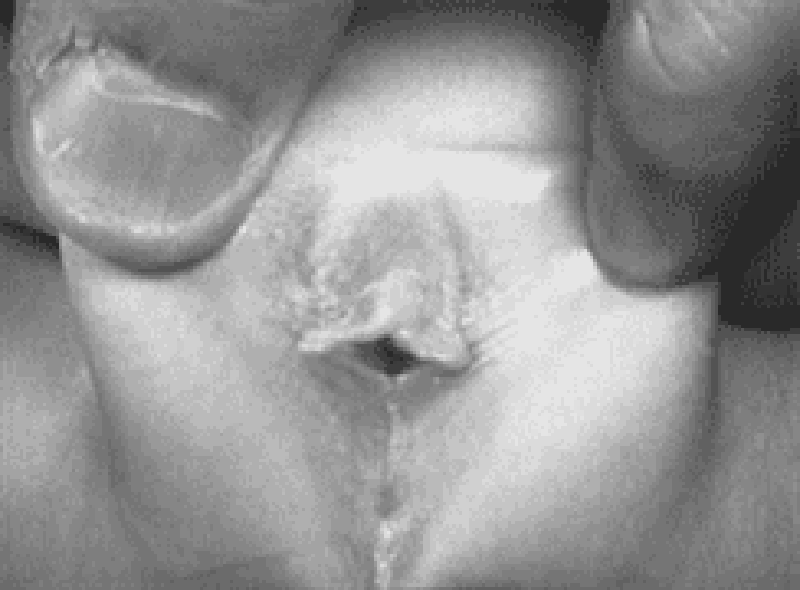
82) You are seeing a 4-year-old girl with the physical examination finding shown below. She has no significant past history. The most appropriate management is which of the following?
. Surgical consultation for correction
. Topical estrogen cream daily for a week
. Topical steroid cream for a week
. Referral to social services for possible sexual abuse
. Karyotypestudies
83) At the 2-week checkup of a term female infant, the mother reports a grayish and sometimes bloody vaginal discharge since birth. The infant’s mother and grandmother are the only caretakers. Examination of the external genitalia reveals an intact hymen with a thin grayish mucous discharge. Which of the following is the most appropriate next step?
. Parental reassurance
. MRI of the brain
. Ultrasound of the abdomen
. Gonorrhea and chlamydial swabs
. Referral to social services for possible sexual abuse
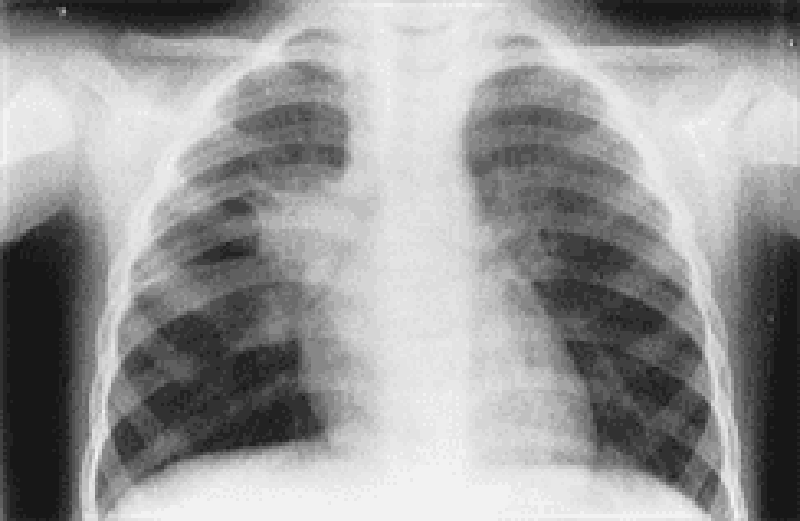
84) A 3-year-old girl is admitted with the x-ray shown below. The child lives with her parents and a 6-week-old brother. Her grandfather stayed with the family for 2 months before his return to the West Indies 1 month ago. The grandfather had a 3-month history of weight loss, fever, and hemoptysis. Appropriate management of this problem includes which of the following?
Bronchoscopy and culture of washings for all family members
Placement of a Mantoux test on the 6-week-old sibling
Isolating the 3-year-old patient for 1 month
Treating the 3-year-old patient with isoniazid (INH) and rifampin
HIV testing for all family members
85) A 9-year-old African-American boy is brought to ER with high fever, poor appetite, and irritability. His heart rate is 140/min and his blood pressure is 80/60 mmHg. He has been hospitalized several times before for poorly localized abdominal pain. He also has a history of hematuria. The boy has not received several routine vaccinations because his mother is afraid that they will cause autism. His hematocrit is 22% and the reticulocyte count is 12%. The patient dies several hours after the admission. This patient's death may have been prevented by which one?
Folic acid supplementation
Vaccination with a live attenuated virus
Vaccination with a bacterial toxoid
Vaccination with a conjugate capsular polysaccharide
Periodic blood transfusions
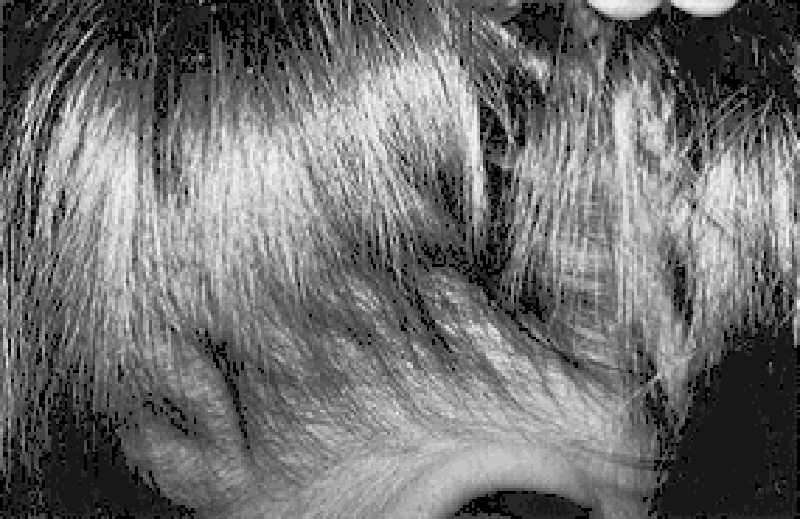
86) A mother arrives to the clinic with her three children (ages 2 months, 18 months, and 36 months). The 18-month-old has an intensely pruritic scalp, especially in the occipital region, with 0.5-mm lesions noted at the base of hair shafts, as shown in the picture. Which of the following therapies should be avoided in this situation?
Treatment of all household contacts with 1% lindane (Kwell)
Use of 1:1 vinegar-water rinse for hair for nit removal
Washing of all clothing and bedding in very hot water
Replacement of all commonly used brushes
Advice to the mother that treatment will again be necessary in 7 to 10 days
87) An infant born at term to a 22-year-old woman has a weak cry and is cyanotic at birth. His fingertips and oral mucosa appear blue. His blood pressure is 80/40 mmHg and his heart rate is 140/min. Chest x-ray shows clear lung fields bilaterally. PaO2 measured by arterial cannulation is 38 mmHg, and improves only minimally on 100% inspired oxygen. Which of the following is the best next step in managing this patient?
. Loop diuretics
. Packed red blood cell transfusion
Prostaglandin E1 infusion
. Low dose beta-blocker
Single dose of indomethacin
88) An 8-week-old female infant is brought to the office by her Caucasian mother for a well-baby examination. She was born at 34 weeks gestation, and weighed 2.9kg (6.5 Ib) at birth. She has been exclusively breastfed since birth, and her growth and development are normal for her age. The physical examination is normal, except for mild pallor. At this time, what is the most appropriate nutritional intervention for this patient?
Vitamin C supplementation
Iron supplementation
Inclusion of vegetables in diet
Inclusion of fruit juices in diet
Introduce egg and meat in diet
89) A 6-year-old boy is brought to the clinic due to persistent leg pain. Over the last few months, he has been constantly complaining of pain in his legs. The painful episodes occur only at night, and last a few hours each. His mother has been treating him with over-the-counter medications. He is able to walk and run to school without any complaints. He has no fever, chills and history of trauma. On examination, there is no obvious trauma to his legs, and the limb exam is completely normal. His parents are very worried and ask that you "do something.” Which of the following is the most appropriate next step in management?
Plain radiographs
Bone scan
Blood cultures
Psychiatric evaluation
Observation and reassurance
90) A 1-year-old presents for a well-child checkup, but the parents are concerned about giving the child his immunizations. Which of the following is a true contraindication to the administration of the fourth DTaP (diphtheria and tetanus toxoid and acellular pertussis) vaccine?
Child is currently on amoxicillin for an otitis media
Positive family history of adverse reactions to DTaP vaccine
A past history of infantile spasms
Child is currently febrile to 39 C (102.2 F)
Prolonged seizures 6 days after the last DTaP vaccine
91) An 11-year-old boy presents with fever and sore throat. A rapid-strep test confirms streptococcal pharyngitis. He is leaving for a summer camp in 2 days. In the past, he has had problem finishing the whole course of antibiotic treatment. Which of the following is the best treatment for his streptococcal pharyngitis?
. A single dose of benzathine penicillin G intramuscularly
. A single dose of ceftriaxone intramuscularly
. A single dose of procaine penicillin G intramuscularly
Erythromycin orally for 5 days
Penicillin V orally for 5 days
92) A 6-year-old boy is brought to the office by his mother for the evaluation of a "skin disease." The physical examination reveals multiple vesiculopustular lesions on his face and neck. Some lesions are colored golden-yellow and encrusted. The crust is thick and adherent to the underlying skin. The rest of his physical examination is within normal limit. What is the most appropriate treatment for his skin condition?
. Topical erythromycin
. Topical mupirocin
. Oral penicillin
. Topical dicloxacillin
. Topical cephalexin
93) A 15-year-old Caucasian boy is injured during a football game. He is taken to the emergency department for x-ray films of his leg to rule out a possible fracture. The radiologist reports that the boy has evidence of an aggressive bone tumor with both bone destruction and a soft tissue mass. Later, the pathologist reports that the bone biopsy reveals a bone cancer with some of the tumor tissue displaying neural differentiation. Which of the following is the most appropriate next step in management?
Chemotherapy
Radiation therapy
Surgery
Surgery and chemotherapy
Surgery, chemotherapy, and radiation therapy
94) A 7-year-old boy has a history of repeated urinary tract infections that have been treated by the empiric use of antibiotics. The parents are not satisfied with the care the child is receiving, and they take him to a pediatric urologist. Evaluation by voiding cystourethrogram shows that the patient has vesicoureteral reflux without ureteral or upper tract dilatation (grade one reflux). Which of the following is the appropriate management for this child?
Alpha blockers
Long-term, low-dose antibacterial therapy
Nephrectomy on the affected site
Reassurance and observation
Surgical reimplantation of the ureter
95) A previously healthy 4-year-old girl is brought to the office due to a 12-day history of persistent, thick, nasal discharge, nasal congestion, headache, cough, and intermittent low-grade fever. The cough is worse at night, but there is no wheezing. Her temperature is 37.2C (99F), pulse is 90/min, and respirations are 15/min. Examination shows an alert, interactive child breathing comfortably. She has clear tympanic membranes, congested posterior nasal pharynx with thick and purulent mucus, and red, swollen nasal turbinates. Her maxillary sinuses are mildly tender. Her lungs are clear on auscultation. What is the most appropriate next step in the management of this patient?
X-ray paranasal sinuses
CT scan of sinuses
Sinus aspiration
Start the patient on decongestants
Start the patient on oral amoxicillin
96) A 16-year-old boy with a history of ulcerative colitis presents to the physician complaining of diarrhea and a rash. He states that his appetite has been decreased recently, and also complains of nausea and abdominal pain in addition to watery diarrhea. He has an erythematous rash on his distal arms and legs that "burns". His mother reports that he has had poor concentration and has been irritable lately. Vital signs are stable. Examination reveals a beefy red tongue that appears swollen. Abdominal examination is normal. The rash resembles a sunburn and is located on his distal arms and legs. It is symmetrical and tender to palpation. Neurological examination is normal. This patient's symptoms are most likely due to a deficiency of which of the following vitamins?
Thiamine
Riboflavin
Niacin
Pyridoxine
Cyanocobalamin
97) You are called by a general practitioner to consult on a patient admit- ted to the hospital 4 days ago. The patient is a 7-month-old white boy with poor weight gain for the past 3 months, who has not gained weight in the hospital despite seemingly adequate nutrition. You take a detailed diet his- tory from his foster mother, and the amounts of formula and baby food intake seem appropriate for age. Physical examination reveals an active, alert infant with a strong suck reflex who appears wasted. You note generalized lymphadenopathy with hepatomegaly. In addition, you find a severe case of oral candidiasis that apparently has been resistant to treatment. Which of the following is the most appropriate next step in the evaluation or treatment of this child?
Increase caloric intake because this is probably a case of underfeeding
Order human immunodeficiency virus (HIV) polymerase chain reaction (PCR). Testing because this is likely the presentation of congenitally acquired HIV
Draw blood cultures because this could be sepsis
Perform a sweat chloride test because this is probably cystic fibrosis
Send stool for fecal fat because this is probably a malabsorption syndrome

98) A 5-year-old boy presents with the severe rash shown in the photographs. The rash is pruritic, and it is especially intense in the flexural areas. The mother reports that the symptoms began in infancy (when it also involved the face) and that her 6-month-old child has similar symptoms. Which of the following is the most appropriate treatment of this condition?
Coal-tar soaps and shampoo
Topical antifungal cream
Ultraviolet light therapy
Moisturizers and topical steroids
Topical antibiotics
99) A 13-year-old girl returns to her physician for followup of a strep throat, for which she had been treated 3 weeks previously. After performing a throat culture, the physician asks how school is going. There is dead silence. Her mother says that her daughter has missed the last 4 weeks of school. Which of the following is the most appropriate initial step in management?
Contract with the girl to go back to school as you explore the problem
Write a medical excuse for her until the throat culture results come back
Tell them you must report her to the school authorities for truancy
Send the mother for supportive counseling
Send the girl for psychotherapy
100) A 1 -year old child is brought in for a well-baby check-up. His parents report that he has been of good health and began walking a few weeks earlier. They are concerned that he tends to bump into things and falls more than his older sister did. Family history is significant for retinoblastoma. On examination, the pediatrician notes leukocoria of the left eye. No significant lymphadenopathy is present, and there is no enlargement of the liver or spleen. The child's height and weight are normal for age. Which of the following is the most appropriate next step in management?
Explain to parents what leukocoria is and reassure them that it is temporary
Return visit in 1 month
Refer to neurologist
Refer to ophthalmologist
Treat the eye with erythromycin ophthalmic ointment for 10 days
101) A 4-year-old boy presents with 5-day history of fever and increased irritability. His temperature is 40.2 C (104.3 F), blood pressure is 98/68 mm Hg, pulse is 112/min, and respirations are 24/min. On physical examination, he is noted to have bilateral cervical lymphadenopathy, cracked lips, strawberry tongue, and bilateral conjunctival injection. His palms and soles are erythematous. There is a polymorphous macular rash generalized on his body. Which of the following is the most appropriate pharmacotherapy?
. Amoxicillin
. Aspirin and corticosteroid
. Aspirin and IV immune globulin
. Corticosteroid
. IV immune globulin
102) A 16-year-old male, despondent over a recent breakup, tries to commit suicide by taking an unknown quantity of an unknown material he found at home. He is brought to the emergency center by his parents within 30 minutes of the ingestion. For which of the following household materials and medications should he be given activated charcoal as part of his emergency center treatment?
. Drain cleaner
. Ethylene glycol
. Bleach
. Phenobarbital
. Lithium
103) A previously healthy 2-year-old male is brought to the emergency department after experiencing a seizure-like episode. His parents report that he has been healthy with the exception of mild upper respiratory symptoms for the past 24 hours. During the episode, his parents state that he fell down and had rhythmic, jerking movements of his arms and legs. The episode lasted about three minutes. The patient was sleepy when the emergency personnel arrived. Vital signs are temperature 39.2 c (102.5 F), pulse 120/min, and respiratory rate 25/min. The patient is alert and oriented in the emergency department. On examination, there is mild rhinorrhea and the left tympanic membrane is erythematous, bulging, and poorly mobile. The neck is supple. A complete neurological exam is unremarkable. After treating this patient's fever, which of the following is the next best step in the management of this patient?
Electroencephalogram
Magnetic resonance imaging of the brain
Lumbar puncture
Discharge home with education
Admit for further observation
104) A 15-year-old female with a history of bipolar disorder and psychosis presents to her physician's office requesting a pregnancy test. Her last menstrual period was 2 months ago. She states that her menses usually occur every 30 days. She is sexually active with one partner and occasionally uses condoms. She is concerned because she has gained 10 pounds in the last two months, and also complains of breast tenderness and milky white discharge from both nipples. She denies headaches, nausea, vomiting, diarrhea, or fever. Her vital signs are normal. Physical examination is unremarkable. A urine pregnancy test is negative. Which of the following is most likely responsible for this patient's symptoms?
Valproic acid
Risperidone
Aripiprazole
Lithium
Lamotrigine
105) A 14-year-old boy is seen in the ER because of a 3-week history of fever between 38.3C and 38.9C (101F and 102F), lethargy, and a 2.7-kg (6-lb) weight loss. Physical examination reveals marked cervical and inguinal adenopathy, enlarged tonsils with exudate, small hemorrhages on the soft palate, a WBC differential that has 50% lymphocytes (10% atypical), and a palpable spleen 2 cm below the left costal margin. Which of the following therapies should be initiated?
. Initiation of zidovudine
. IV acyclovir
. IV infusion of immunoglobulins and high-dose aspirin
Intramuscular penicillin
. Avoidance of contact sports
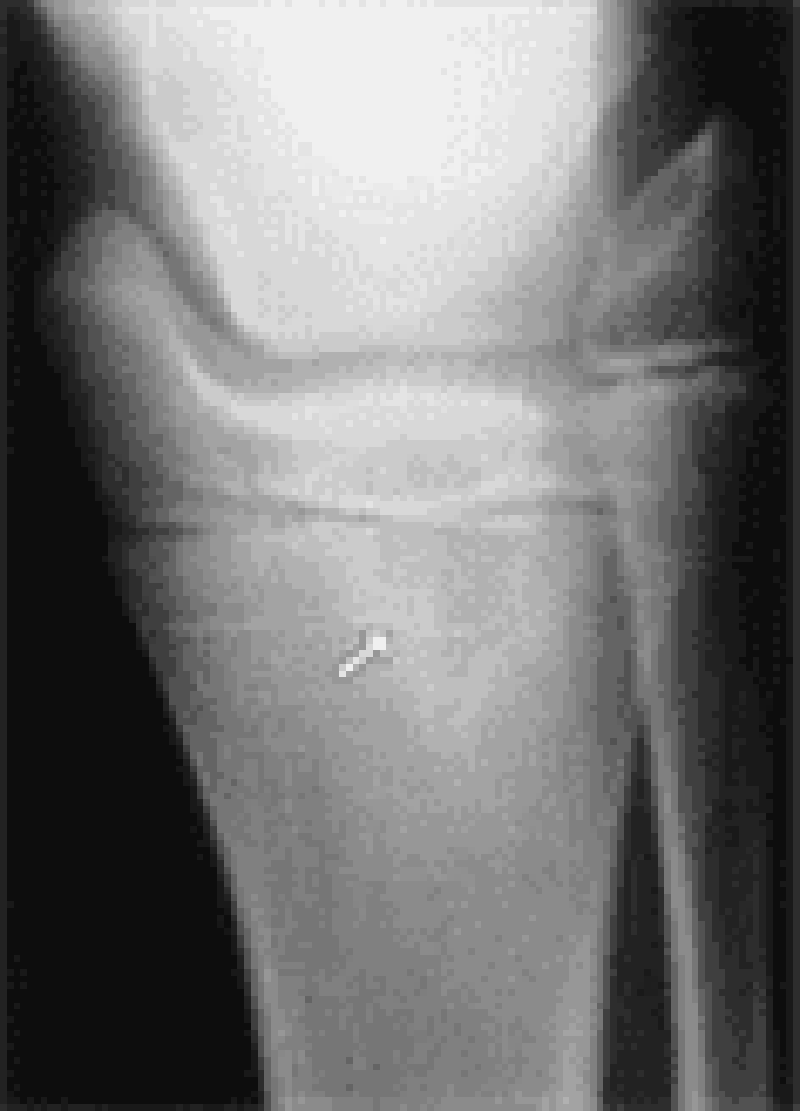
106) A 2-year-old child is seen in the emergency center with a 10-day complaint of fever and a limp. The child has an elevated erythrocyte sedimentation rate (ESR) and the radiograph shown below. Which of the following statements about this child’s condition is correct?
. It is most commonly caused by Streptococcus pyogenes
. It can arise following development of deep cellulitis
. It usually results in tenderness in the region of infection that is diffuse, notlocalized
. It causes diagnostic radiographic changes on plain films within 48 hours of the beginning of symptoms
. It requires antibiotic therapy usually for 10 to 14 days
107) A 12-year-old boy with cystic fibrosis presents to the emergency department with a 3-day history of severe coughing, which is productive of a yellow-greenish purulent sputum. He had fever and chills at home. He also complains of chest congestion and chest pain that is worse with coughing. On physical examination, his temperature is 39.6 C (103.2 F), blood pressure is 98/68 mm Hg, pulse is 102/min, and respirations are 24/min. He is noted to be lethargic. He has rales on the left lower lung field on auscultation, and chest radiography shows an infiltrate in the left lower lobe. Which of the following is the most appropriate initial antimicrobial therapy for this patient?
Amoxicillin-clavulanate and gentamicin
Azithromycin and ceftriaxone
Ceftazidime and tobramycin
Levofloxacin and metronidazole
Trimethoprim-sulfamethoxazole and vancomycin
108) A 14-year-old high school student arrives to your clinic for well-child care. In reviewing his records you determine that his most recent immunization for tetanus was at 4 years of age. Which of the following should you recommend?
Tetanus toxoid
Adult tetanus and diphtheria toxoid (Td)
Diphtheria toxoid, whole cell pertussis, and tetanus toxoid (DPT) booster
Tetanus toxoid and tetanus immune globulin
Tetanus toxoid, reduced diphtheria toxoid, and acellular pertussis vaccine adsorbed (Tdap)
109) A 15-month-old boy is brought to the ER because of fever and a rash. Six hours earlier he was fine, except for tugging on his ears; another physician diagnosed otitis media and prescribed amoxicillin. During the interim period, the child has developed an erythematous rash on his face, trunk, and extremities. Some of the lesions, which are of variable size, do not blanch on pressure. The child is now very irritable, and he does not interact well with the examiner. Temperature is 39.5C (103.1F). He continues to have injected, immobile tympanic membranes, but you are concerned about his change in mental status. Which of the following is the most appropriate next step in the management of this infant?
Begin administration of IV ampicillin
Begin diphenhydramine
Discontinue administration of ampicillin and begin trimethoprim with sulfamethoxazole
Perform bilateral myringotomies
. Perform a lumbar puncture
110) The 3-year-old sister of a newborn baby develops a cough diagnosed as pertussis by nasopharyngeal culture. The mother gives a history of having been immunized as a child. Which of the following is a correct statement regarding this clinical situation?
. The mother has no risk of acquiring the disease because she was immunized
. Hyperimmune globulin is effective in protecting the infant
. The risk to the infant depends on the immune status of the mother
. Erythromycin should be administered to the infant
. The 3-year-old sister should be immediately immunized with an additional dose of pertussis vaccine
{"name":"DES 2016. Final (Part 51)", "url":"https://www.quiz-maker.com/QPREVIEW","txt":"11) A female infant is born full-term to a 24-year-old Caucasian primigravida. The delivery was uncomplicated. The Apgar scores were 7 and 8 at 1 and 5 minutes, respectively. The prenatal course was complicated with asymptomatic bacteriuria that was treated with an antibiotic. The mother took multivitamins during her last trimester, occasionally took acetaminophen for back pain throughout the pregnancy, and denies smoking and alcohol consumption. Physical examination of the infant reveals a blood-tinged vaginal discharge and bilaterally enlarged mammary glands. What is the best next step in the management of this patient?, 12) The mother of a 2-year-old girl reports that her daughter complains of burning when she urinates and that she has foul-smelling discharge from her vagina. She has some slight staining on the front of her underwear, but denies fever, nausea, vomiting, or other constitutional signs. The child does not attend day care, and she has demonstrated no change in behavior. The physical examination is normal with an intact hymen, but the child’s vulva is reddened and with a malodorous scent noted. Her urinalysis and culture are normal. Management of this condition includes which of the following?, 13) A 12-year-old boy comes to the emergency department at midnight with a complaint of severe scrotal pain since 7 PM. There is no history of trauma. Which of the following is the most appropriate first step in management?","img":"https://cdn.poll-maker.com/11-522622/evaliu.png?sz=1200"}
More Quizzes
Handel Quiz
520
Q7 BIOL130 p1
50250
Who are you most like in BTS?
1260
E&R
8425
Louis Tomlinson: Test Your Fan Knowledge Now!
201029873
Test Your Spanish Vocabulary: Verb, Noun & Adjective
201035242
Ultimate State Trivia: How Well Do You Know US States?
201032924
Free American Indian Tribes Geography
201023355
Free SHSAT Practice Test Online
201024126
Free: Master French Irregular Conditional Verbs
201043569
Free Far-Right Extremism Knowledge for Students
201021674
Trading Personality Test: Discover Your Trader Type
201028283